Intel Z68 Chipset & Smart Response Technology (SSD Caching) Review
by Anand Lal Shimpi on May 11, 2011 2:34 AM ESTAnandTech Storage Bench 2011
With the hand timed real world tests out of the way, I wanted to do a better job of summarizing the performance benefit of Intel's SRT using our Storage Bench 2011 suite. Remember that the first time anything is ever encountered it won't be cached and even then, not all operations afterwards will be cached. Data can also be evicted out of the cache depending on other demands. As a result, overall performance looks more like a doubling of standalone HDD performance rather than the multi-x increase we see from moving entirely to an SSD.
Heavy 2011—Background
Last year we introduced our AnandTech Storage Bench, a suite of benchmarks that took traces of real OS/application usage and played them back in a repeatable manner. I assembled the traces myself out of frustration with the majority of what we have today in terms of SSD benchmarks.
Although the AnandTech Storage Bench tests did a good job of characterizing SSD performance, they weren't stressful enough. All of the tests performed less than 10GB of reads/writes and typically involved only 4GB of writes specifically. That's not even enough exceed the spare area on most SSDs. Most canned SSD benchmarks don't even come close to writing a single gigabyte of data, but that doesn't mean that simply writing 4GB is acceptable.
Originally I kept the benchmarks short enough that they wouldn't be a burden to run (~30 minutes) but long enough that they were representative of what a power user might do with their system.
Not too long ago I tweeted that I had created what I referred to as the Mother of All SSD Benchmarks (MOASB). Rather than only writing 4GB of data to the drive, this benchmark writes 106.32GB. It's the load you'd put on a drive after nearly two weeks of constant usage. And it takes a *long* time to run.
First, some details:
1) The MOASB, officially called AnandTech Storage Bench 2011—Heavy Workload, mainly focuses on the times when your I/O activity is the highest. There is a lot of downloading and application installing that happens during the course of this test. My thinking was that it's during application installs, file copies, downloading and multitasking with all of this that you can really notice performance differences between drives.
2) I tried to cover as many bases as possible with the software I incorporated into this test. There's a lot of photo editing in Photoshop, HTML editing in Dreamweaver, web browsing, game playing/level loading (Starcraft II & WoW are both a part of the test) as well as general use stuff (application installing, virus scanning). I included a large amount of email downloading, document creation and editing as well. To top it all off I even use Visual Studio 2008 to build Chromium during the test.
The test has 2,168,893 read operations and 1,783,447 write operations. The IO breakdown is as follows:
| AnandTech Storage Bench 2011—Heavy Workload IO Breakdown | ||||
| IO Size | % of Total | |||
| 4KB | 28% | |||
| 16KB | 10% | |||
| 32KB | 10% | |||
| 64KB | 4% | |||
Only 42% of all operations are sequential, the rest range from pseudo to fully random (with most falling in the pseudo-random category). Average queue depth is 4.625 IOs, with 59% of operations taking place in an IO queue of 1.
Many of you have asked for a better way to really characterize performance. Simply looking at IOPS doesn't really say much. As a result I'm going to be presenting Storage Bench 2011 data in a slightly different way. We'll have performance represented as Average MB/s, with higher numbers being better. At the same time I'll be reporting how long the SSD was busy while running this test. These disk busy graphs will show you exactly how much time was shaved off by using a faster drive vs. a slower one during the course of this test. Finally, I will also break out performance into reads, writes and combined. The reason I do this is to help balance out the fact that this test is unusually write intensive, which can often hide the benefits of a drive with good read performance.
There's also a new light workload for 2011. This is a far more reasonable, typical every day use case benchmark. Lots of web browsing, photo editing (but with a greater focus on photo consumption), video playback as well as some application installs and gaming. This test isn't nearly as write intensive as the MOASB but it's still multiple times more write intensive than what we were running last year.
As always I don't believe that these two benchmarks alone are enough to characterize the performance of a drive, but hopefully along with the rest of our tests they will help provide a better idea.
The testbed for Storage Bench 2011 has changed as well. We're now using a Sandy Bridge platform with full 6Gbps support for these tests. All of the older tests are still run on our X58 platform.
AnandTech Storage Bench 2011—Heavy Workload
We'll start out by looking at average data rate throughout our new heavy workload test:
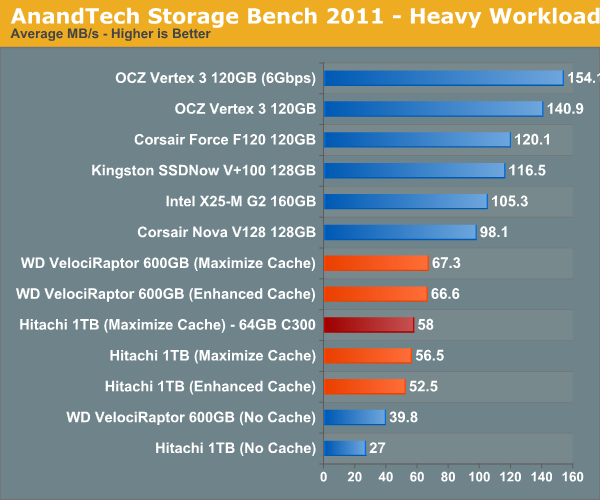
For this comparison I used two hard drives: 1) a Hitachi 7200RPM 1TB drive from 2008 and 2) a 600GB Western Digital VelociRaptor. The Hitachi 1TB is a good large, but aging drive, while the 600GB VR is a great example of a very high end spinning disk. With a modest 20GB cache enabled, the 3+ year old Hitachi drive is easily 41% faster than the VelociRaptor. We're still not into dedicated SSD territory, but the improvement is significant.
I also tried swapping the cache drive out with a Crucial RealSSD C300 (64GB). Performance went up a bit but not much. You'll notice that average read speed got the biggest boost from the C300 as a cache drive since it does have better sequential read performance. Overall I am impressed with Intel's SSD 311, I just wish the drive were a little bigger.
The breakdown of reads vs. writes tells us more of what's going on:
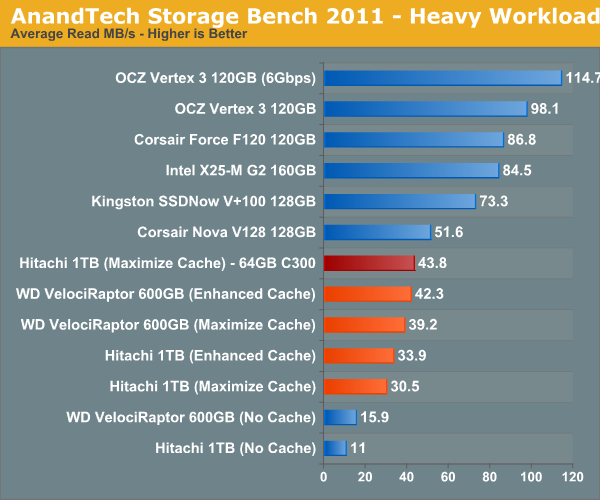
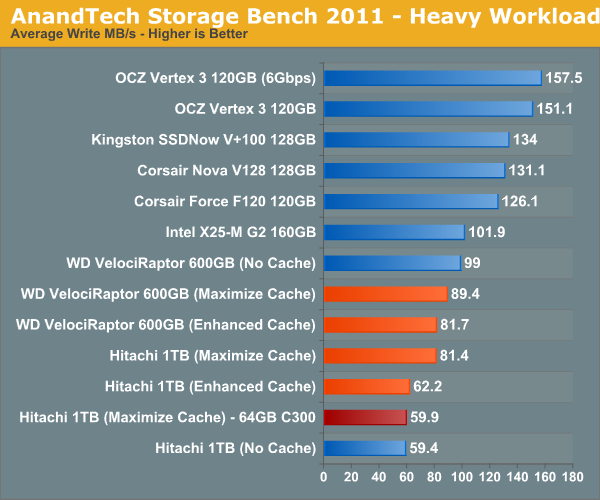
This isn't too unusual—pure write performance is actually better with the cache disabled than with it enabled. The SSD 311 has a good write speed for its capacity/channel configuration, but so does the VelociRaptor. Overall performance is still better with the cache enabled, but it's worth keeping in mind if you are using a particularly sluggish SSD with a hard drive that has very good sequential write performance.
The next three charts just represent the same data, but in a different manner. Instead of looking at average data rate, we're looking at how long the disk was busy for during this entire test. Note that disk busy time excludes any and all idles, this is just how long the SSD was busy doing something:
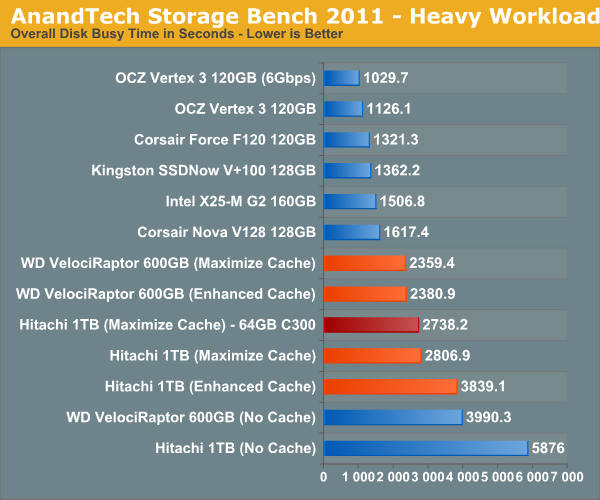
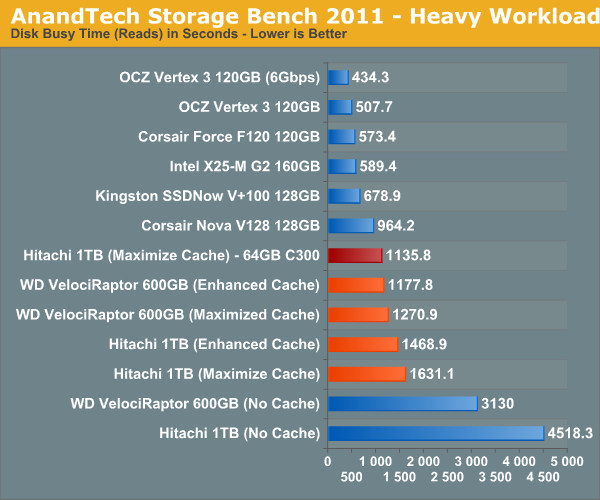











106 Comments
View All Comments
JarredWalton - Wednesday, May 11, 2011 - link
Obviously, I missed changing the pasted text above. That's Bold, Italics, and underlined text. (And highlighted text is now gone, thankfully, so people talking about [H]OCP don't look weird. LOL)Mr Perfect - Thursday, May 12, 2011 - link
I hadn't though to try BBCode[\b[\i][\u].Thanks, Jarred.
Mr Perfect - Thursday, May 12, 2011 - link
Much less use it correctly...FlameDeer - Thursday, May 12, 2011 - link
Hi Jarred, about the option to do links, I have tried before, by using the below codes:[L=text]/[/L] = [L=AnandTech]http://www.anandtech.com/[/L]
The codes I put are
<L=AnandTech>http://www.anandtech.com/</L>
just replace the < > symbols to [ ] will do. :)
Hopefully Intel will be more concern about what the users really needs & not just simply apply their own set of rules to users by limiting certain functions as they like.
Good job of the review & take care, guys! :)
FlameDeer - Thursday, May 12, 2011 - link
Ops, not working, anyway I try again few codes here, if still not working then just abandon it.[ L ]/[ /L ] = [L]Text[/L]
[ A ]/[ /A ] = [A]Text[/A]
[ B ]/[ /B ] = Text
[ I ]/[ /I ] = Text
[ U ]/[ /U ] = Text
[ H ]/[ /H ] = [H]Text[/H]
therealnickdanger - Wednesday, May 11, 2011 - link
Obviously, a lot of time goes into these reviews, but I would really like to see an update using a 64GB Vertex 3 or other fast 64GB drive as the cache. I suppose that the only real improvement would be how many apps/files are cached before eviction. But the Vertex 3 is a LOT faster than the new Intel 311 or whatever it is...y2kBug - Wednesday, May 11, 2011 - link
Take this with a huge grain of salt. The following quote from the review makes me shiver “In my use I've only noticed two reliability issues with Intel's SRT. The first issue was with an early BIOS/driver combination where I rebooted my system (SSD cache was set to maximized) and my bootloader had disappeared. The other issue was a corrupt portion of my Portal 2 install, which only appeared after I disabled by SSD cache.”Don’t get me wrong, I’m not trolling. I was really looking forward to SSD caching. But my previous experience when I randomly lost all data on an Intel RAID 1 array without any signs of hard-drive failures made me skeptical in the Intel RAID software.
NCM - Wednesday, May 11, 2011 - link
Anand writes: "Paired with a 20GB SLC SSD cache, I could turn a 4-year-old 1TB hard drive into something that was 41% faster than a VelociRaptor."That's an assertion that really needs some heavy qualification, for instance by appending "at least sometimes and for certain things."
SRT is an intriguing approach on the part of Intel, but ultimately it comes across to me as insufficient and unfinished. I have little confidence in its ability to gauge what's important to cache as opposed to what's used more often. Those aren't the same things at all.
I'd like to see a drive approach where a limited capacity boot/application SSD is combined with a conventional HD within a single standard drive enclosure. This hybrid would present itself to the host as a single drive, but include a software toggle to allow selective access to each drive for setup purposes. You'd install the OS and programs on the SSD for rapid boot/launch, while user mass file storage would be on the HD. In normal use you wouldn't know, other than in performance terms, that two devices were involved.
Yes, I know that we can achieve much of that today by using separate SSD and HD devices. I have two such setups, one a server and the other a workstation. However they both require some technical attention on the part of the user, and it's not an approach that works in a laptop, at least not without big compromises.
LancerVI - Wednesday, May 11, 2011 - link
Can install OS on 1 60 GB SSD for example and then SRT a second 60 SSD for a 2 TB Raid 0 array?I've got two 60's in a Raid 0 now, but obviously, most of my programs are on seprate HDD's. If my above question is possible, maybe this is a way to split the difference as it were.
Any insight would be appreciated.
djgandy - Wednesday, May 11, 2011 - link
Considering you can pick up a 30GB SSD in the UK for £45, this seems like an easy way to get some performance increase for desktop productivity.http://www.overclockers.co.uk/showproduct.php?prod...